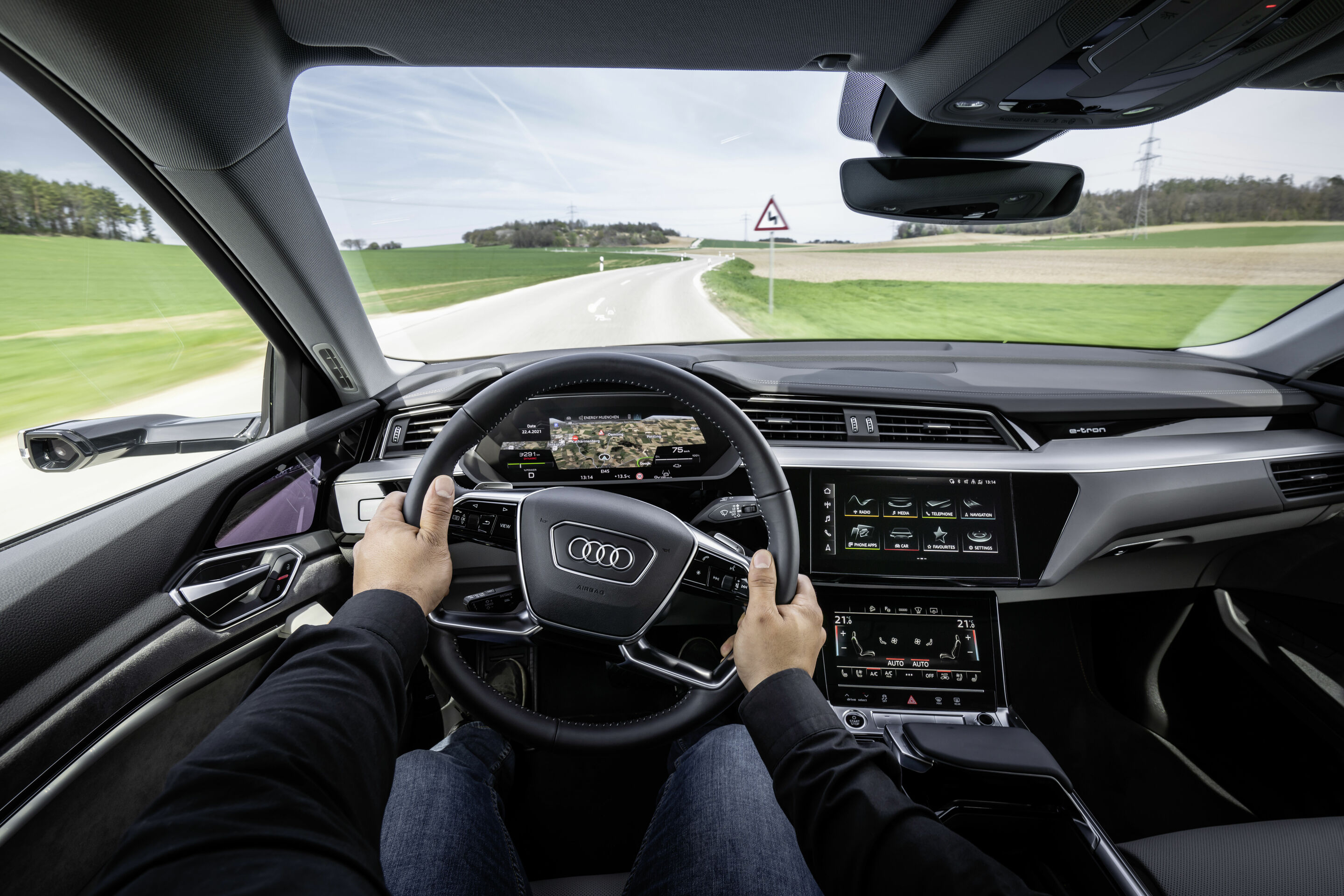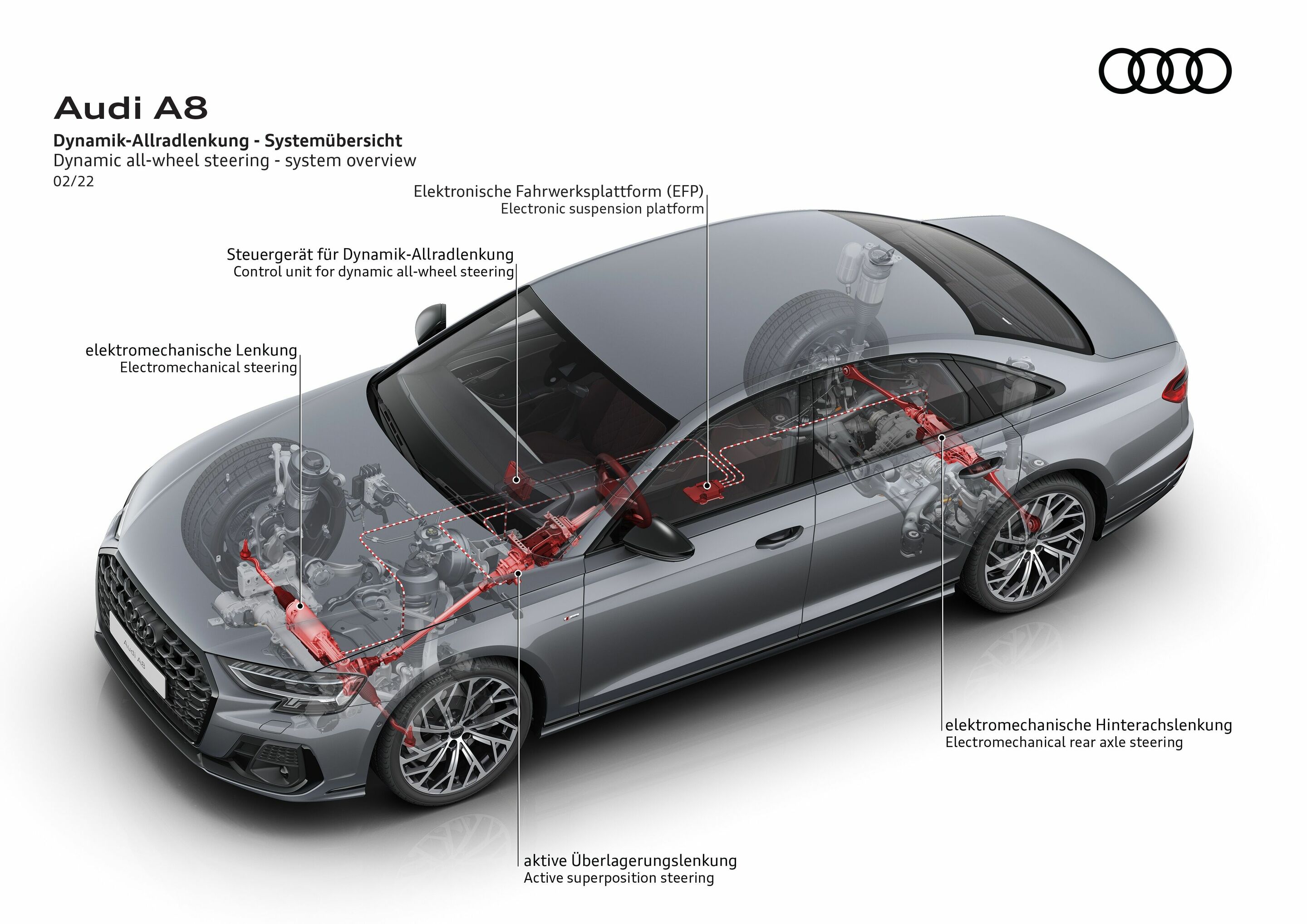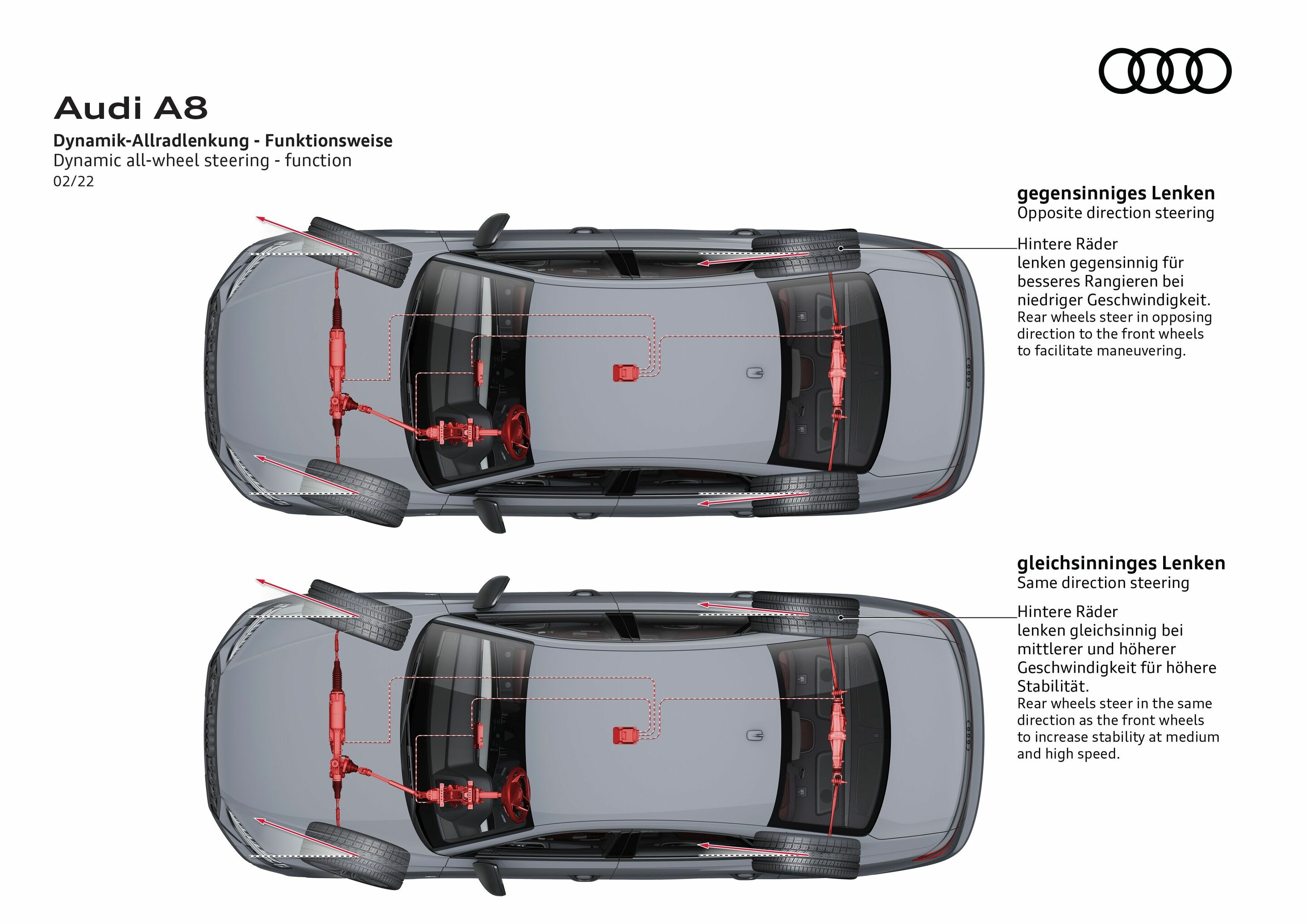Search
All search results for "Dynamik-Allradlenkung "
(53)
 Fine-tuning the characteristics of the Audi steering system
Fine-tuning the characteristics of the Audi steering system
With increasing demands on driving dynamics and handling in larger vehicles such as the Q7 and Q8, we also use rear-axle steering. How is a steering system calibrated – on a computer or in the real world? Both. What we refer to as basic calibration is largely carried out virtually. We have developed standardized driving and steering maneuvers that we simulate over a vehicle’s entire speed range. We mainly focus on the range in which the average customer drives, as the linear range with low lateral forces and normal steering frequencies. But we also push the limits to evaluate the vehicle’s handling at high levels of lateral acceleration and fast steering frequencies. Basic calibration works extremely well with this approach, especially for complex systems such as dynamic all-wheel steering. But it obviously does not deliver results worthy of final approval. What’s the next step in the fine-tuning process? It isn’t yet possible to fine-tune and harmonize all the chassis components with each other via simulations. We can only properly assess the steering feel by testing it out on the road. This requires trial runs to determine whether the settings we’ve selected during basic calibration are headed in the right direction. For this purpose, we first test-drive the vehicle on different test tracks. Both objective and subjective criteria are taken into account during the calibration process. We ask ourselves questions like: how is the car’s self-steering behavior? Does the steering wheel transmit the driver’s commands directly or indirectly to the wheels? Does it give the driver a good feel for the road surface? Is the steering wheel responsive or sluggish? And what do you do if you discover that the wheel hasn’t been properly calibrated? If a test drive reveals that something needs to be changed or that we should try a different setting, we make the necessary modifications and promptly head out for the next test drive.

The S sports suspension with damper control, dynamic all-wheel steering, and ceramic brake system leave nothing to be desired in terms of cornering dynamics and deceleration. The distinctive design of the premium S-model gives the sporty luxury class model a truly unique presence.
Pictures Audi A6 Sedan TDI (until 2025)
Video Audi A6 Sedan TDI (until 2025)
Engine type V6 engine
Displacement in cc / bore x stroke in mm / compression 2967 / 83.0 x 91.4 / 16.3
Max. power output in kW (PS) / at rpm 253 (344) / 3850 - 4000
Max. torque in Nm (lb-ft) / at rpm 700 (516.3) / 1750 - 3250
Top speed in km/h (mph) 250 (155.3) (governed)
Acceleration, 0-100 km/h (0-62.1 mph) 5.0
Fuel consumption, combined in l/100 km (US mpg) 7.3 - 6.9 (32.2 - 34.1)
CO2 emissions, combined in g/km (g/mi) 191 - 182 (307.4 - 292.9)
CO2 class G
Unladen weight without driver / with driver / gross weight limit in kg (lb) 1955 (4310.0) / 2030 (4475.4) / 2590 (5710.0)

The S sports suspension with damper control, dynamic all-wheel steering, and ceramic brake system leave nothing to be desired in terms of cornering dynamics and deceleration. The distinctive design of the premium S-model gives the sporty Avant a truly unique presence.
Pictures Audi A6 Avant (until 2025)
Video Audi A6 Avant (until 2025)
Engine type V6 engine
Displacement in cc / bore x stroke in mm / compression 2967 / 83.0 x 91.4 / 16.3
Max. power output in kW (PS) / at rpm 253 (344) / 3850 - 4000
Max. torque in Nm (lb-ft) / at rpm 700 (516.3) / 1750 - 3250
Top speed in km/h (mph) 250 (155.3) (governed)
Acceleration, 0-100 km/h (0-62.1 mph) 5.1
Fuel consumption, combined in l/100 km (US mpg) 7.4 - 7.1 (31.8 - 33.1)
CO2 emissions, combined in g/km (g/mi) 195 - 186 (313.8 - 299.3)
CO2 class G
Unladen weight without driver / with driver / gross weight limit in kg (lb) 2020 (4453.3) / 2095 (4618.7) / 2655 (5853.3)

The S sport suspension with damping control, dynamic all-wheel steering and the ceramic brake system tick all the boxes for dynamic cornering and deceleration. The striking design with the sophisticated looks of an S model lends this sporty full-size model particular presence.
Images Audi RS 7 Sportback (until 2025)
Video Audi RS 7 Sportback (until 2025)
Engine type V6 engine
Displacement in cc / bore x stroke in mm / compression 2967 / 83.0 x 91.4 / 16.3
Max. power output in kW (PS) / at rpm 253 (344) / 3850 - 4000
Max. torque in Nm (lb-ft) / at rpm 700 (516.3) / 1750 - 3250
Top speed in km/h (mph) 250 (155.3) (governed)
Acceleration, 0-100 km/h (0-62.1 mph) 5.1
Fuel consumption, combined in l/100 km (US mpg) 7.4 - 7.1 (31.8 - 33.1)
CO2 emissions, combined in g/km (g/mi) 194 - 186 (312.2 - 299.3)
CO2 class G
Unladen weight without driver / with driver / gross weight limit in kg (lb) 2010 (4431.3) / 2085 (4596.6) / 2635 (5809.2)
 The New Audi S8 – Exhilarating Performance in the Luxury Class (2019)
The New Audi S8 – Exhilarating Performance in the Luxury Class (2019)
V8 high-performance engine with 420 kW and 800 Nm (590 lb-ft) of torque Unique combination of innovative suspension systems ensures outstanding vehicle dynamics straight from the factory Typical S model: Design draws attention to the elegance of the dynamic athlete
The new Audi S8** combines progressive luxury with dynamic athleticism while honing its reputation as the benchmark for Vorsprung durch Technik with innovative suspension systems. Its 4.0 TFSI engine – a biturbo eight-cylinder unit – produces 420 kW (571 hp) and an opulent 800 Nm (590 lb-ft) of torque (combined fuel consumption in l/100 km: 11.3–11.4* (20.8–20.6 US mpg); combined CO2 emissions in g/km: 258–260* (415.2–418.4 g/mi)). It is combined with MHEV technology for the perfect symbiosis of efficiency and comfort with exhilarating performance. The predictive active suspension, dynamic-all-wheel steering and quattro drive with sport differential provide for outstanding vehicle dynamics straight from the factory. The new Audi S8** uses specific design elements to express the sporty elegance of the sophisticated luxury sedan with pinpoint precision.
* Fuel/power consumption and CO2 emission figures given in ranges depend on the tires/wheels used as well as the selected equipment ** The collective fuel consumption values of all models named and available on the German market can be found in the list provided at the end of this press information. Impressive performance: the drive system As a V8 engine with mild hybrid technology, the high-performance powerplant in the Audi S8** offers not only maximum smoothness, but with an output of 420 kW (571 PS), 800 Nm (590.0 lb-ft) of torque (combined fuel consumption in l/100 km: 11.3–11.4* (20.8–20.6 US mpg); combined CO2 emissions in g/km: 258–260* (415.2–418.4 g/mi)) and two turbochargers also the certainty that ample power is available for any situation.
 Glossary: Technical terms about steering
Glossary: Technical terms about steering
Dynamic all-wheel steering, which can also vary the steering ratio by using superimposition gearing on the front axle, is an expansion of the system. D for dynamic steering: Dynamic steering varies its degree of implementation up to 100 percent, depending on driving speed, steering angle, and the mode selected in the Audi drive select dynamic handling system. The central component is the superimposition gearing in the steering column. It conveys the driver’s steering commands just as directly as in a vehicle with a conventional steering column. There is also a direct mechanical link to the actual steering gear on the front axle and the associated feedback to the forces on the wheels. When the superimposition gearing is controlled by the electric motor, it increases or decreases the steering angle, which constantly adjusts the steering ratio according to the given driving situation. That improves steering comfort and tracking behavior in accordance with speed and driving situation. At low driving speeds – in city traffic and while maneuvering – dynamic steering operates very directly; all it takes is two full turns to go from end stop to end stop. The power steering boost is also high, which makes parking and maneuvering easier. On country roads, the directness of the steering response and electric assistance are progressively reduced. Indirect gear ratios and low power assist are used to smooth out unsteady steering movements and enable straight tracking at fast expressway speeds. directional stability: Directional stability is the vehicle’s ability to drive straight without extensive steering corrections. Directional stability depends not only on the steering mechanism, but also on the chassis, tires, aerodynamics, and wind conditions. O for oversteering: Oversteering is when the car tends to swivel or swing outward, with the rear toward the outer edge of the curve.
 We’ve got the hang of it
We’ve got the hang of it
The developers at Audi are working on the perfect combination of dynamic handling and comfort. At the same time, steering assistance functions offer added safety and support in everyday driving – for changing lanes, swerving, and parking. As a result, the steering wheel is increasingly emerging as a communication device, moving away from the standard wheel and toward becoming a high tech command center.
What constitutes the steering feel typically found in an Audi? Hand moment and feedback are crucial for steering feel. Every Audi can be smoothly and precisely steered with minimal effort while maneuvering and parking – the car drives effortlessly. That is another way of saying it has low hand moment. This increases at higher speeds. The result is agile handling and optimized driving dynamics – the vehicle can be moved through curves with precision. Its sporty character is undergirded by a controlled, stable feeling in the steering wheel’s middle position. This is noticeable during steady, straight driving at expressway speeds, which is affected not only by speed, but also by side winds that arise and road conditions. The driver still has to countersteer, but with significantly less hand moment. A sensor continuously measures the wheel’s steering angle. The steering wheel’s self-aligning force is always noticeable precisely from its middle position and increases perceptibly up to high lateral force. Optimal steering feel also means that a car responds to steering commands with an imperceptible time delay. The latency between steering wheel and implementation on the axles only amounts to a few milliseconds. What factors affect steering feel? The steering balance is fundamentally affected by the big three of driving physics: longitudinal, lateral, and vertical dynamics.

The Audi A7 Sportback impresses with even more dynamic driving on the one hand and increased comfort on the other. Thanks to numerous chassis innovations, the Gran Turismo from Audi offers a new range between comfort and dynamics. The mild-hybrid technology, which is also new, makes the drive system even more efficient and at the same time more comfortable. Furthermore, the A7 will be hitting the road with updated engines. Chassis New chassis components enable the four-door Gran Turismo to perfect its synthesis of sportiness and long-distance comfort. The new Audi A7 Sportback handles more agilely and spontaneously yet is also safer and more comfortable. This has been achieved using innovative technologies such as dynamic all-wheel steering, damper control and controlled power distribution by the quattro sport differential. The central control of these system via the electronic chassis platform (ECP) make this synthesis of sportiness and comfort possible. With the standard progressive steering and the optional dynamic all-wheel steering and sport differential, the A7 achieves the handling characteristics of a compact sports car. The dynamic all-wheel steering combines the dynamic steering at the front axle, which works with strain wave gearing, with a separate rear axle steering system with a spindle drive. This makes it possible to independently adjust the steering angles at the front and rear axles. The dynamic all-wheel steering ends the conflict of aims between agile response and stability. At speeds up to 60 km/h (37.3 mph), the rear wheels are turned as much as five degrees in the opposite direction. This reduces the turning circle by up to 1.1 meters (3.6 ft), and the car becomes more agile in city traffic, when maneuvering and in tight switchbacks. At 60 km/h (37.3 mph) and above the rear wheels turn in the same direction as the front wheels.





